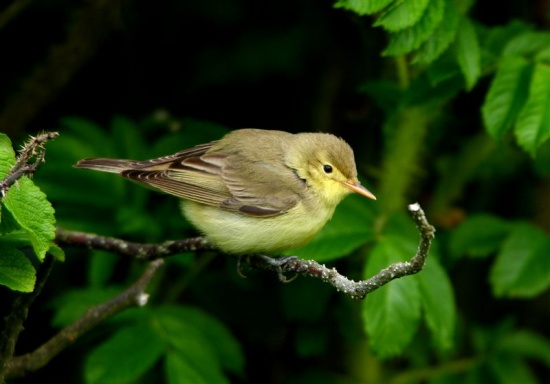- Hippolais icterina
Identification
12.5–14cm, 4.9-5.5 inches, 11–16 g, 0.39-0.53 oz
Adult
- Large head
- Crown and upperparts greeny grey
- Often has raised feathers of fore-crown
- Short indistinct yellow supercilium
- Pale loral area giving an open faced appearance
- Flight feathers and upper wing-coverts are darker grey than crown
- Edges of tertials, secondries and greater coverts whitish or pale forming a pale wing panel in fresh plumage on closed wing, but can be absent when worn (summer)
- Long primary projection equal to at least three quarters of length of visible tertials
- Pale yellow throat and underparts
- Retrices have thin pale edges and tips
- Iris dark
- Strong pointed beak
- Upper mandible greyish
- Lower mandible pinkish yellow
- Grey legs, but may have a faint bluish hue
- Sexes are identical
Immature
- Upperparts have brownish hue
- Wing panel is yellowish grey or pale green
- Underparts tend to be paler than adult and rarely an off-white colour, lacking any yellow.
Distribution
Breeds from Scandinavia and southern Finland east to west-central Russia, (east bank of the Ob river), south to northeast France, southern Germany, Romania and locally northern Balkans, Ukraine, Crimea and region east of Sea of Azov and northern Iran.
Winters to southern Africa.
Taxonomy
This is a monotypic species[1].
Habitat
Open deciduous woodland, including oak (Quercus), birch (Betula), beech (Fagus sylvatica), alder (Alnus), stands of young pine (Pinus) if in mixed woodland, bushes and also parks and gardens, often near water. Also enjoys dense woods with open glades and undergrowth.
Frequents lowlands in north of range, wooded hills and mountain slopes up to 1500 m in south.
Behaviour
Breeding
End of May to July, but mainly starts breeding in June. Usually single brood.
The nest consists of a neat cup built with grasses, plant stems moss and soft twigs, covered with birch bark, lichens and flowers which are attached using cobwebs. The nest is lined with fur, fine fibres and roots. It is placed in the fork of a tree branch or bush 1-4 m above the ground, but occasionaly up to 7 m.
The clutch consists of 4 to 5 eggs, which are mainly incubated by the female for 12-14 days. The fnestings are feed by both parents and fledge at 13-15 days.
Diet
Diet consists mainly of insects and other inverebrate, including mayflies (Ephemeroptera), dragonflies (Odonata), grasshoppers (Orthoptera), earwigs (Dermaptera), bugs (Hemiptera, including aphids), scorpion flies (Mecoptera), moths and butterflies (Lepidoptera), caddis flies (Trichoptera), dipteran flies, ants, wasps and bees (Hymenoptera), beetles (Coleoptera), spiders (Araneae), small molluscs and earthworms.
Berries and fruits are eaten when seasonally available and include buckthorn (Rhamnus), bramble (Rubus), cherry (Prunus), pear (Pyrus), medlar (Mespilus), rowan (Sorbus aucuparia), currant (Ribes), privet (Ligustrum), elder (Sambucus), mulberry (Morus), fig (Ficus).
Forages mainly in upper canopy area where it is constanly moving similar to, but slower and more clumsily than large Phylloscopus warbler as it is larger in size. Will take prey on the wing. Visits lower levels to feed and ground level in sheltered parts of woodland.
Movement
Migratory with non-breeding movement to Africa south of the equator from southern Uganda and eastern DR Congo south to Namibia and northern and eastern South Africa. Leaves breeding areas from the end of July to early September arriving at wintering locations between late September and November. The return migration starts in late February/early March, with arrival in late April in south of range and mid May to mid June in northern Europe
Vocalisation
Song is a loud mix of shrill or melodious notes and mimicry, delivered with gusto, usually at a fast pace, sometimes slowing to give one clear note at a time, often recognised by recurring nasal “gih-e”, but also by typical trisyllabic calls. Mimicry varies individually, the best mimics copy the sounds of Eurasian Oystercatcher, Common Tern, Tawny Owl, Eurasian Blackbird, Whinchat, etc.
Call a melodic, quick “tey-te-dwee” (or rendered “deederoit”); also a single “chek”. Alarm a drawn out sequence of hard notes, “te-te-te-te-te-tek”, similar to Melodious Warbler. When anxious, a softer whistling “dwuee”.
References
- Clements, J. F., P. C. Rasmussen, T. S. Schulenberg, M. J. Iliff, T. A. Fredericks, J. A. Gerbracht, D. Lepage, A. Spencer, S. M. Billerman, B. L. Sullivan, and C. L. Wood. 2023. The eBird/Clements checklist of Birds of the World: v2023. Downloaded from https://www.birds.cornell.edu/clementschecklist/download/
- Avibase
- Svensson, L. (2020). Icterine Warbler (Hippolais icterina), version 1.0. In Birds of the World (J. del Hoyo, A. Elliott, J. Sargatal, D. A. Christie, and E. de Juana, Editors). Cornell Lab of Ornithology, Ithaca, NY, USA. https://doi.org/10.2173/bow.ictwar1.01
Recommended Citation
- BirdForum Opus contributors. (2025) Icterine Warbler. In: BirdForum, the forum for wild birds and birding. Retrieved 15 May 2025 from https://www.birdforum.net/opus/Icterine_Warbler
External Links
GSearch checked for 2020 platform.1






